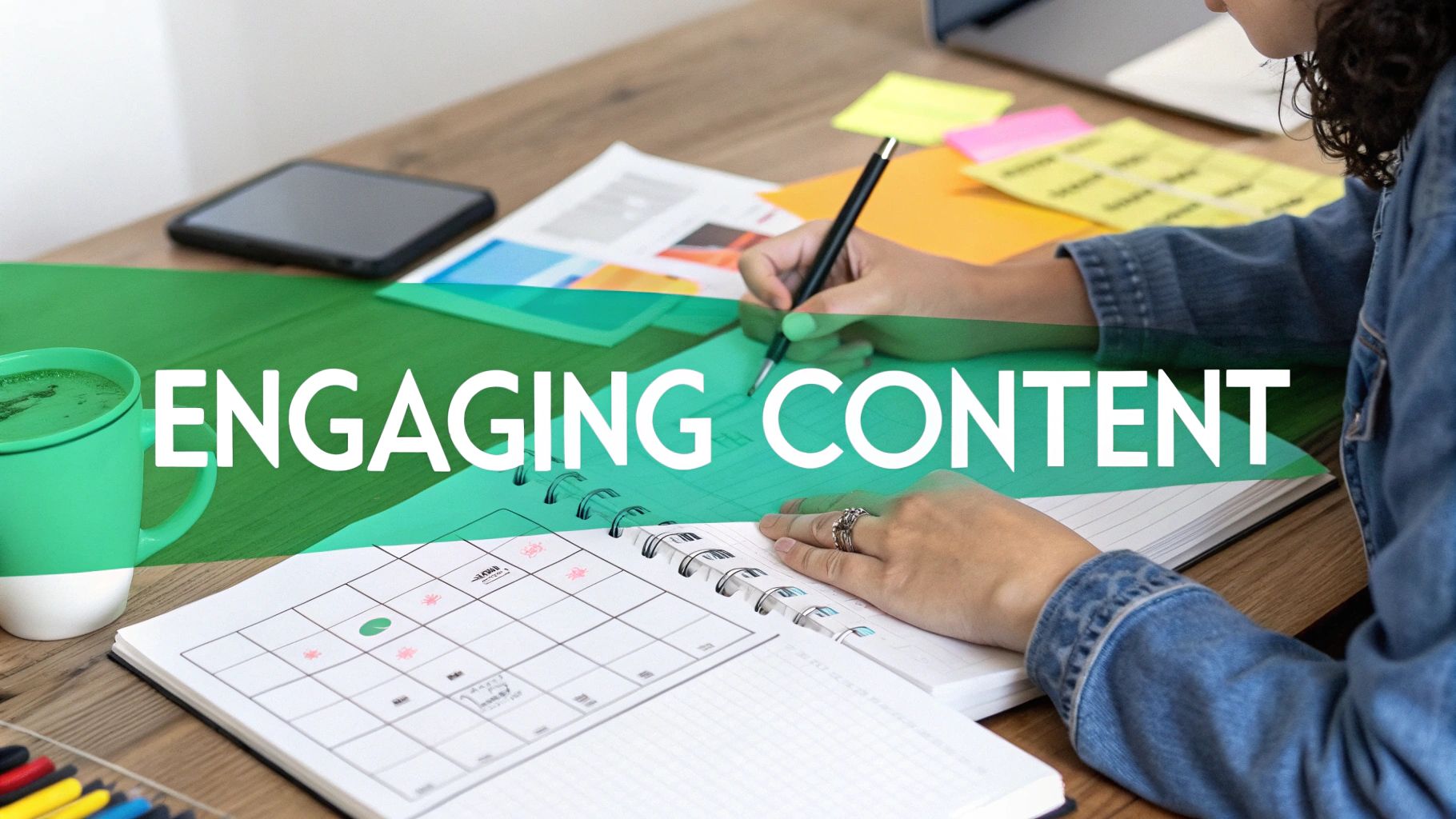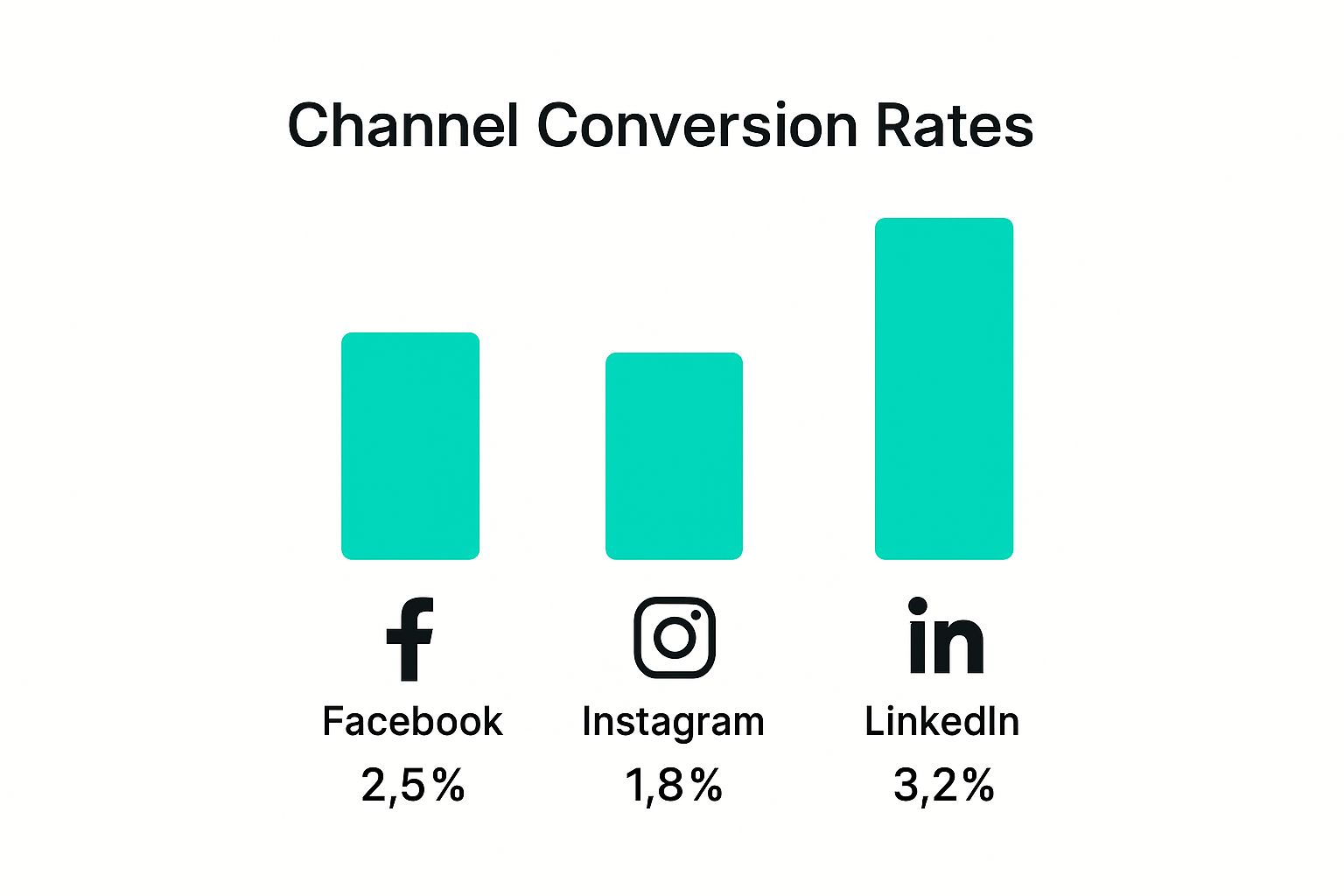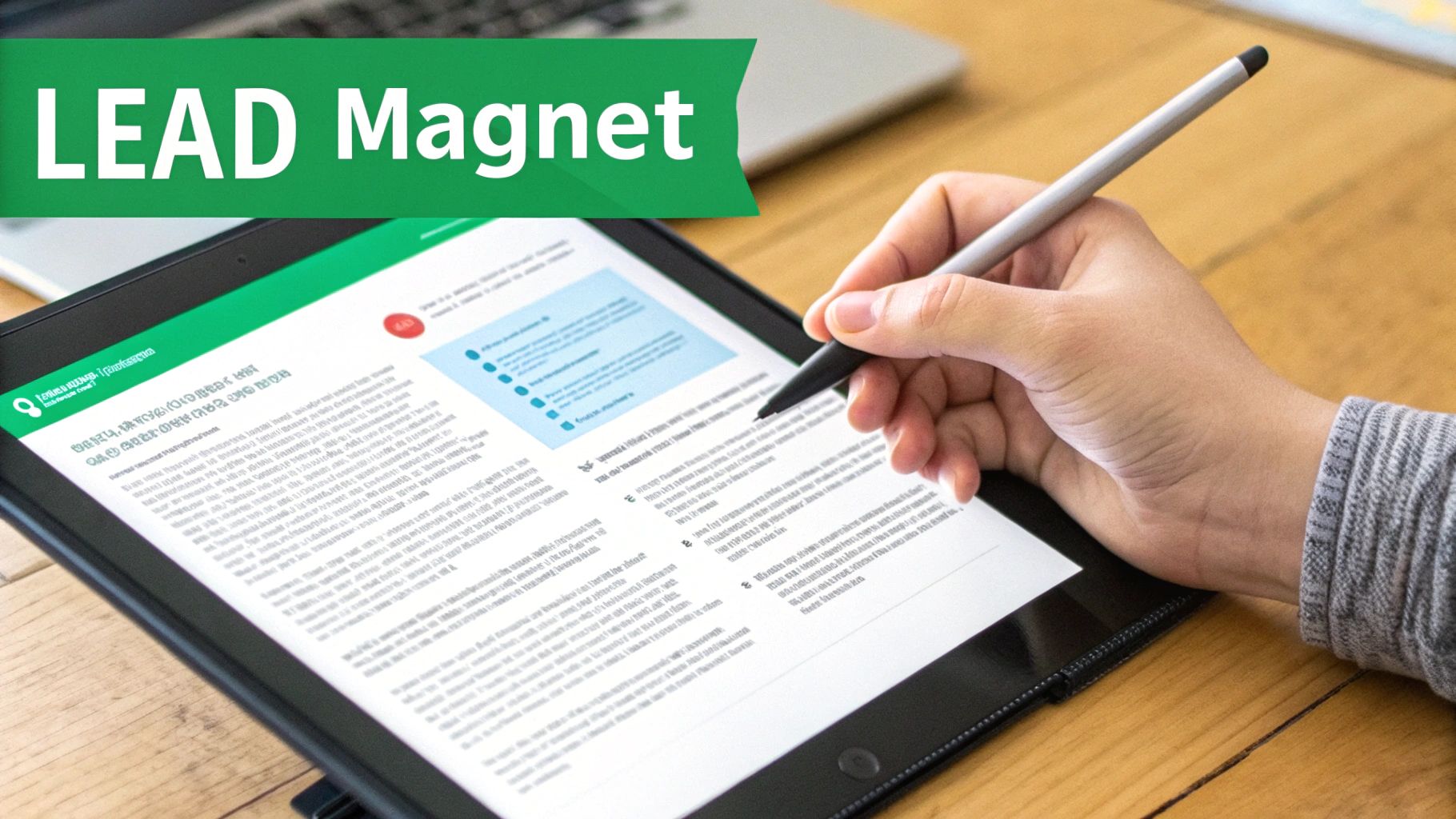Effective Lead Generation Social Media Strategies
So, what exactly is lead generation on social media? Put simply, it’s the art of finding potential customers on platforms like LinkedIn, Facebook, and Instagram and getting their contact information. It’s about turning your followers from passive scrollers into people genuinely interested in what you offer by sharing valuable content, running smart ads, and, most importantly, building real relationships. This whole process lets you connect with interested individuals and gently guide them toward making a purchase.
How Social Media Transforms Lead Generation

Let's ditch the buzzwords for a minute and talk about what this really looks like. Think of social media lead generation less like shouting your sales pitch into a crowd and more like starting a helpful conversation in a room filled with your ideal customers. It’s a complete shift away from old-school interruption marketing.
Instead of bugging people with cold calls or mass emails they never asked for, you’re creating a space where potential customers willingly raise their hands. This whole ecosystem, built on platforms from LinkedIn to Facebook, is perfect for building trust and nurturing interest long before you ever ask for a sale. The real goal here is to become the obvious choice when they finally need a solution.
Before we dive deeper, let's break down the core components that make this all work.
| The Core Pillars of Social Media Lead Generation | |
|---|---|
| Pillar | Description |
| Engagement | Building trust and credibility by consistently providing valuable content and interacting with your audience. |
| Targeting | Using platform tools to pinpoint and reach your ideal customers based on demographics, interests, and behaviors. |
| Native Tools | Leveraging built-in features like lead forms to make it incredibly easy for people to share their information. |
| Listening | Paying attention to conversations to identify pain points and offer solutions directly where your audience is active. |
These pillars work together to create a powerful, sustainable engine for finding and converting high-quality leads.
Building Trust Through Engagement
Genuine engagement is the real currency on social media. When you consistently share valuable stuff—whether it’s a smart article, a quick tutorial, or just an entertaining video—you start to build authority and credibility. This creates a foundation of trust that makes people far more open to hearing what you have to offer down the line.
Every little interaction, from a simple like to a thoughtful comment, is a tiny signal of interest. It shows that your audience is paying attention. This is how you warm up a lead, by letting them get to know your brand's personality and expertise without any sales pressure. You can learn more about managing your brand’s presence in our guide on social media reputation monitoring.
Social media is not just a broadcast channel; it's a listening post. The best lead generators are the best listeners, identifying pain points and offering solutions directly within conversations.
Leveraging Platform-Native Tools
Today's social platforms are packed with powerful tools built specifically for capturing leads. Features like native lead forms on Facebook and LinkedIn make the whole process seamless. A user can hand over their information with just a couple of clicks, often without ever leaving the app they're scrolling.
The sheer scale and targeting capabilities of these platforms are what make them so essential. Meta’s apps alone reach over 3 billion monthly users, while Instagram Stories pull in more than 500 million daily users. This kind of reach lets you zero in on prospects based on their demographics, interests, job titles, and online behavior, making sure your message always lands in front of the right people.
What Modern Lead Generation Looks Like

The days of casting a wide, impersonal net and just hoping for the best are long gone. Modern lead generation on social media is all about data, genuine connections, and providing value long before you ever ask for a sale. It’s about being a resource, not just a retailer.
Think of it this way: old-school marketing was like a loud commercial interrupting your favorite TV show. Today's approach is more like creating a captivating show that people actually choose to watch, subscribe to, and share. Your content becomes the main attraction.
This value-first mindset is no longer optional. Social media marketing is now a powerhouse for finding high volumes of leads, with 68% of marketers confirming it has helped them increase their lead counts. You can dig into more lead generation stats to see the full impact on modern business strategies. This shift proves one thing: the best way to attract potential customers is to earn their attention, not demand it.
The Content and Lead Capture Connection
At the heart of any good social media lead gen strategy is a simple, powerful exchange: you give value, they give you their contact info. Your content is the engine driving this whole process, acting as that first handshake with a potential customer.
Great content does more than just fill up a feed; it solves a problem, answers a burning question, or offers a fresh perspective. When you consistently deliver that kind of value, you build trust and establish yourself as an authority. This makes your audience far more willing to take the next step, whether that’s downloading a guide, signing up for a webinar, or requesting a demo.
Here’s how this connection plays out in the real world:
- A compelling blog post can lead a reader to a downloadable checklist that expands on the topic.
- An engaging video tutorial might prompt viewers to sign up for a free trial to try the technique themselves.
- An insightful LinkedIn article can direct professionals to register for an exclusive industry webinar.
In each scenario, the content builds credibility and creates a natural path for a prospect to raise their hand and identify themselves as a lead.
The Lifecycle of a Modern Lead
Getting a lead is a crucial first step, but it’s just one piece of the puzzle. The real challenge—and where a lot of businesses stumble—is what happens next. A lead isn’t just a name in a database; it’s the start of a relationship that needs careful nurturing.
The biggest disconnect in modern marketing isn't a lack of leads, but a breakdown in the follow-up process. Generating interest is only half the battle; sustaining it is what drives revenue.
This gap is a massive problem. Shockingly, 44% of sales reps admit they’re too busy to properly follow up with the leads they get. That means nearly half of the hard-earned interest you generate on social media can go to waste simply because there isn't a solid system in place to handle it. A cohesive strategy that bridges marketing and sales is essential.
Understanding why older methods fail can give you some valuable context. For a deeper look, check out our article explaining why cold outreach doesn't work anymore and how relationship-building has taken its place. A successful system doesn’t just find leads; it has a clear, timely, and often automated process for engaging, qualifying, and ultimately converting them into loyal customers.
Choosing the Right Platform for Your Audience
Not all social media platforms are created equal, and this is especially true when it comes to generating leads. Spreading your efforts too thin across every channel is a classic recipe for wasted resources and disappointing results. The key is to stop guessing and start making strategic choices based on one simple question: where do your ideal customers actually spend their time?
Think of it like fishing. You wouldn't cast your line in a desert pond hoping to catch a marlin. By the same token, you shouldn't be promoting your B2B software on a platform dominated by Gen Z dance challenges. An effective lead generation social media strategy starts by perfectly matching your message, your audience, and your platform.
This means you have to move beyond surface-level assumptions. Each platform has its own unique culture, user expectations, and content formats that get the best results. Understanding these nuances is what separates campaigns that pull in high-quality leads from those that just make a lot of noise.
Aligning Platform Strengths with Your Goals
To pick the right channels, you need to look at the distinct strengths of the major players. LinkedIn, Facebook, Instagram, and TikTok each offer different opportunities for capturing leads. What works wonders on one can fall completely flat on another.
The way social media platforms are built fundamentally shapes how you can generate leads. Different platforms excel with different kinds of engagement and audiences, which directly impacts how well they work for lead capture. For example, TikTok leads the pack with an organic engagement rate of 2.5% per post on average, and that number can soar to 7.5% for accounts under 100,000 followers. This makes it a powerhouse for viral content and awareness-driven lead gen.
On the other hand, LinkedIn is tailored for B2B audiences and sees high engagement rates on multi-image posts (6.6%), native documents (5.85%), and videos (5.6%). This signals its strong potential for gathering high-quality professional leads. You can dig into more social media engagement stats on sprinklr.com.
This data makes one thing crystal clear: your content format must align with platform expectations if you want to drive action.
A Deeper Dive into Top Platforms
Let's break down the primary channels and their specific advantages for generating leads, whether you're targeting businesses (B2B) or consumers (B2C).
LinkedIn: The Professional Powerhouse With its business-first user base, LinkedIn is the undisputed champion for B2B lead generation. People are on the platform to network, learn, and advance their careers, which makes them incredibly receptive to professional content. This is the place for in-depth articles, industry reports, webinars, and case studies. Plus, its native Lead Gen Forms make it ridiculously simple for professionals to hand over their info with just a couple of clicks.
Facebook: The Versatile Community Builder Facebook’s massive and diverse user base makes it a powerful tool for both B2B and B2C. Its real strength is in building communities through Groups and running hyper-targeted ad campaigns. For B2C, things like contests, special offers, and event sign-ups work exceptionally well. For B2B, Facebook is great for targeting specific job titles and interests with educational content that leads to a gated resource.
Instagram: The Visual Storyteller As a visually-driven platform, Instagram is a goldmine for B2C brands in e-commerce, fashion, travel, and wellness. Product discovery is huge here. Lead generation tactics often involve interactive Stories with polls and quizzes, "link in bio" tools that direct to landing pages, and influencer collaborations that promote exclusive offers. While it's less direct for B2B, it can be effective for showcasing company culture and attracting top talent.
The platform itself is only part of the equation. Success comes from understanding the mindset of the user on that platform. Are they looking to learn, to be entertained, or to connect with friends? Tailor your approach accordingly.
These different user mindsets also directly influence how likely someone is to convert. The infographic below compares the average conversion rates across three major platforms, giving you a clear look at their lead generation performance.

The data speaks for itself—LinkedIn leads the pack, reinforcing its strength in turning professional audiences into real, tangible leads.
To help you quickly see where your efforts might be best spent, here’s a breakdown of which platforms tend to work best for B2B and B2C goals.
Platform Breakdown for B2B and B2C Leads
| Platform | Best For | Audience Type | Top Lead Generation Tactics |
|---|---|---|---|
| B2B lead generation, professional networking, industry leadership | Professionals, decision-makers, B2B buyers | Lead Gen Forms, gated content (whitepapers, reports), webinar sign-ups, InMail | |
| B2C & B2B community building, targeted advertising | Broad consumer demographics, niche professional interests | Lead Ads, contests & giveaways, event registrations, Messenger bots, Facebook Groups | |
| B2C product discovery, brand building, influencer marketing | Younger demographics (Gen Z, Millennials), visual-focused consumers | "Link in bio" landing pages, interactive Stories (polls, quizzes), shopping tags, influencer promotions | |
| TikTok | B2C brand awareness, viral marketing, user-generated content | Primarily Gen Z and younger Millennials | "Link in bio" calls-to-action, lead generation ads in-feed, viral challenges |
This table should give you a solid starting point for deciding where to focus your energy based on who you're trying to reach.
Ultimately, choosing the right platform is all about strategic alignment. Figure out where your target demographic is most active and engaged, then build a content and lead capture strategy that feels native to that environment. A focused approach will always outperform a scattered, one-size-fits-all effort.
Proven Strategies to Capture High-Quality Leads

Alright, this is where the rubber meets the road. Turning likes, shares, and comments into actual leads is the moment your social media efforts start paying the bills. It's the shift from simply building an audience to actively building your business.
The goal here isn't to trick people into handing over their email addresses. Far from it. Real lead generation on social media is all about a fair value exchange. You offer something genuinely useful—a piece of knowledge, a helpful tool, or a unique insight—and in return, your audience gives you their contact info, signaling they're ready to learn more.
Let's dig into the hands-on methods for creating offers people can't refuse and using platform tools to make the whole process seamless. These are the strategies that bring in quality leads, not just names on a list.
Create Irresistible Lead Magnets
The heart of that value exchange is your lead magnet. It's the free goodie you offer in exchange for someone's contact information. For a lead magnet to work, it can't be some generic, dusty PDF. It has to solve a real, specific problem for your target audience, giving them a quick win they can't easily find somewhere else.
Think of it as the first handshake where you prove your expertise. If your freebie is truly helpful, you build instant trust and show that you know your stuff. The idea is to create something so valuable that your ideal customer feels like they're getting a steal just by sharing their email.
Here are a few types of lead magnets that consistently get the job done:
- Downloadable Guides and Checklists: These are perfect for breaking down a big, messy topic into simple, actionable steps. A marketing agency, for instance, might offer a "10-Point Checklist for Auditing Your Social Media Profiles."
- Templates and Worksheets: Practical tools that help people do something faster or better are always a hit. A project management software company could offer a free "Project Kickoff Template" to get teams started.
- Webinars and Workshops: Live or recorded events let you go deep on a topic, answer questions directly, and build a real connection. This format is gold for B2B lead generation.
- Exclusive Case Studies: Nothing beats real-world proof. A detailed case study showing how you achieved results for a client can attract leads who are already looking for solutions.
The trick is to match your lead magnet to the content that brought them to you in the first place. If they just read a blog post on SEO, offering a downloadable SEO checklist is the logical next step. It makes the entire journey feel natural and connected.
Run Targeted Ads with Native Lead Forms
Organic reach is great for building community, but paid ads are how you pour fuel on the fire and scale your lead generation. Platforms like LinkedIn and Facebook have built incredibly smart tools for this, especially native lead forms.
These forms are a game-changer because they remove almost all the friction from the process. When someone clicks your ad, a form pops up right inside the app, already filled out with their name, email, and other profile info. They can hit "submit" in a couple of taps without ever leaving the platform.
This frictionless experience is everything. One study found that Facebook Lead Ads can hit a click-through rate of 2.53%, while standard ads sending people to an external website only get around 1.57%. By cutting out extra steps, you make it way easier for people to say yes.
To get the most out of your ads, make your offer crystal clear and get laser-focused with your targeting. Use the platform's audience tools to reach people based on their job titles, interests, online habits, and demographics. A perfectly targeted ad combined with a simple native lead form is one of the most powerful combos for snagging high-quality leads.
Host Interactive and Engaging Content
Finally, never underestimate the power of interactive content. It's a fantastic way to build a community and capture leads at the same time, because it feels less like marketing and more like a real conversation.
Interactive formats pull your audience in and invite them to participate, which creates a much more memorable experience. When people are actively involved, they become more invested in your brand and are more likely to take that next step.
Consider weaving these powerful interactive strategies into your plan:
- Contests and Giveaways: Offering a cool prize in exchange for a follow, share, and email sign-up is a classic for a reason. It builds excitement and can quickly grow both your reach and your lead list, especially for B2C brands.
- Live Q&A Sessions and "Ask Me Anything" (AMA) Events: Hosting a live video with an expert or your company's founder is a huge value-add. You can require people to register with their email to join the live event or to get access to the recording afterward.
- Quizzes and Polls: People love quizzes that help them diagnose a problem or learn something about themselves. At the end of the quiz, offer to email their personalized results—a fun, low-pressure way to capture their information.
These hands-on approaches turn passive followers into active members of your community, all while keeping your sales pipeline full of qualified leads.
Measuring What Matters for Sustainable Growth
Finding potential customers is just the start. The real magic in lead generation on social media happens when you know your numbers, because what gets measured gets improved. Without a clear picture of what’s working, you're basically flying blind—burning cash on campaigns that fall flat and missing chances to double down on your winners.
Think of it like a ship's captain navigating the ocean. The captain doesn't just point the ship in a general direction and hope for the best. They’re constantly checking their compass, monitoring speed, and adjusting course based on real-time data. Your marketing metrics are those navigational tools, steering you toward steady growth and a much better return on your investment.
Core Metrics for Social Media Lead Generation
To get started, you only need to focus on a handful of key performance indicators (KPIs) that tell the most important parts of your story. These metrics cut through the noise of vanity numbers like "likes" and get straight to what’s driving actual business results.
Here are the essential KPIs to have on your dashboard:
- Lead Conversion Rate: This is the percentage of people who see your offer (like an ad or post) and actually take the desired action to become a lead, like filling out a form. It’s a direct measure of how compelling your offer and creative really are.
- Cost Per Lead (CPL): This metric tells you exactly how much you're spending to acquire each new lead. Just divide your total campaign spend by the number of leads generated. A low CPL means your campaigns are running efficiently.
- Click-Through Rate (CTR): This shows how many people who saw your ad or post clicked on it. While it's not a direct lead metric, a high CTR is a strong signal that your message and visuals are grabbing your audience's attention.
These three metrics work together to give you a complete picture of your campaign's health, from the first flicker of interest to the final conversion.
Translating Data into Actionable Insights
Collecting data is the easy part. The real work is turning those numbers into smart decisions that actually improve your results. Your goal isn't just to report on what happened, but to understand why it happened. This is how you shift from simply running campaigns to strategically optimizing them.
The most valuable insights come from asking questions. Why did one ad crush it while another flopped? Was it the headline, the image, or the audience targeting? Every data point is a clue.
To start turning your data into action, zero in on a few key areas. First, find your top-performing campaigns by looking for the ones with the lowest CPL and highest conversion rates. Dig into what makes them tick—is it the offer, the platform, or a specific audience segment? Once you know what works, you can start replicating that success elsewhere.
This leads directly to the power of A/B testing.
Refining Your Strategy with Testing and Tracking
Continuous improvement is the name of the game on social media. By systematically testing different parts of your campaigns, you can steadily boost your results over time. Just be sure to test one variable at a time—change the headline, swap the image, or tweak the call-to-action—to see what really moves the needle.
To track all of this accurately, UTM parameters are your best friend. These are small bits of code you add to your links that tell your analytics tools exactly where a lead came from. For example, you can create unique UTMs for each ad creative to see precisely which one is bringing in the most conversions on your website.
By combining A/B testing with precise tracking, you create a powerful feedback loop. This data-driven approach lets you continuously refine your audience targeting, improve your ad creative, and ultimately lower your Cost Per Lead. It ensures every dollar you spend is working as hard as possible to fuel your growth.
How AI and Automation Can Scale Your Efforts
As your social media lead generation grows, things can get messy. You’re juggling a constant stream of conversations, trying to qualify prospects, and following up on time. It's easy for manual processes to create bottlenecks, and that’s when valuable opportunities start slipping through the cracks. This is where modern technology steps in—not to replace human connection, but to make it stronger.
Think of AI and automation as the most efficient assistant your marketing team has ever had. This assistant works around the clock, handling all the repetitive stuff with perfect accuracy. That frees up your team to do what they do best: build real relationships and close deals. By bringing these tools into your workflow, you can handle a much higher volume of leads without ever losing that personal touch that builds trust.
Streamlining Lead Qualification and Engagement
One of the best uses for this tech is managing those first few interactions with a new prospect. AI-powered chatbots, for instance, can chat with people on your website or social media 24/7. They can answer common questions, figure out if someone is a good fit based on criteria you set, and even book meetings. No more leaving potential customers waiting for a reply.
That immediate response is a game-changer. On top of that, automation platforms can handle your content scheduling and follow-up sequences. Imagine someone downloads your e-book. An automated workflow can instantly send a thank-you email, then schedule a few follow-up messages over the next couple of weeks to keep your brand on their mind.
These systems make sure every single lead gets a timely, relevant response. This massively improves their experience and makes them much more likely to convert. For a deeper look at specific platforms, check out our complete guide to AI lead generation tools.
Uncovering Hidden Opportunities with AI
Beyond just managing the leads you already know about, AI can find opportunities you would have completely missed. AI-driven social listening tools, like Intently, are constantly scanning millions of conversations across platforms like Reddit and LinkedIn. They’re built to spot high-intent discussions where potential customers are asking for recommendations or complaining about a problem your product solves.
By analyzing sentiment, urgency, and context, these AI agents can surface qualified leads in real time, turning passive social monitoring into an active lead generation social media strategy.
This lets you jump into the right conversation at the perfect moment, offering a helpful solution when prospects are actually looking for one. It’s like having a scout who constantly scans the digital world for your ideal customers, letting you know the second they raise their hand. Using these technologies helps you scale your efforts dramatically and focus your energy on high-value conversations that actually drive business growth.
Common Questions About Social Media Leads
Once you start thinking about a lead generation social media strategy, the practical questions pop up fast. How quickly will I see results? What’s the real difference between a good lead and just another contact? This section cuts through the noise with clear, direct answers.
Think of this as your quick-reference guide. We'll tackle the big questions to help you set the right expectations and build campaigns that actually work. Let's clear up some of the most common uncertainties.
How Long Does It Take to See Results?
This is the million-dollar question, isn't it? And the honest answer is: it depends. A well-targeted paid ad campaign using something like native lead forms can start pulling in leads within 24 to 48 hours. It's fast.
But building a sustainable, organic lead machine takes more time. If your strategy revolves around content and building a community, you need to plan for a longer runway. It usually takes anywhere from three to six months of consistent effort to build the trust and authority needed for a steady flow of inbound leads.
Paid ads give you speed, but organic efforts build a long-term, more cost-effective asset. The sweet spot is often a mix of both.
What Is a Good Lead Conversion Rate on Social Media?
Your lead conversion rate is a vital sign, but what's considered "good" really depends on the platform, your industry, and what you're offering. That said, we can look at some general benchmarks to get a feel for performance.
- Facebook Lead Ads: These often hit conversion rates from 10% to 15%. The in-app forms are just so easy for people to fill out.
- LinkedIn Lead Gen Forms: For B2B, a conversion rate of 5% to 10% is solid, though a super-relevant offer can do even better.
- Landing Pages (from social traffic): When you send people off-platform to a landing page, conversion rates naturally drop to around 2% to 5% because of the extra steps.
The real goal isn't just a high conversion rate; it's getting the right people. A lower conversion rate of highly qualified prospects is always more valuable than a high rate of leads who aren't a good fit.
How Do You Nurture Leads from Social Media?
Getting the lead is just the starting line. The real work—lead nurturing—is where you build the relationship that turns a curious prospect into a paying customer. The key is to keep providing value without coming across as pushy.
As soon as a lead signs up, an automated email workflow is non-negotiable. Kick things off with a welcome email that delivers whatever you promised (like an e-book or webinar link). Over the next few weeks, send a series of helpful emails with extra tips, case studies, or related content.
The idea is to stay top-of-mind and position your brand as a helpful expert. That way, when you do eventually have a sales conversation, it feels natural and welcome.
Discover high-intent leads you're currently missing on social media. Intently uses AI to scan platforms like Reddit and LinkedIn, finding prospects who are actively looking for solutions right now. Start uncovering qualified leads today at intently.ai.
